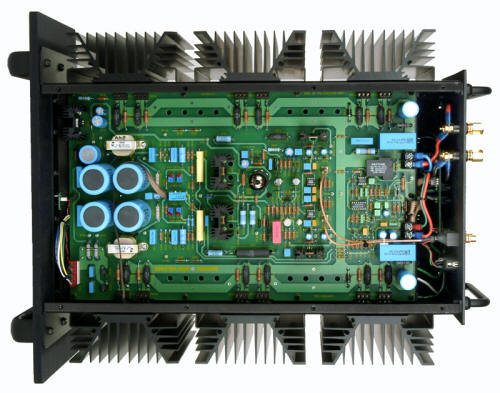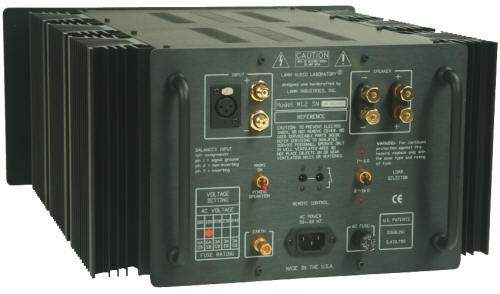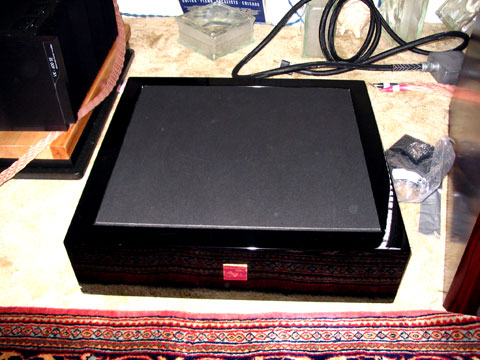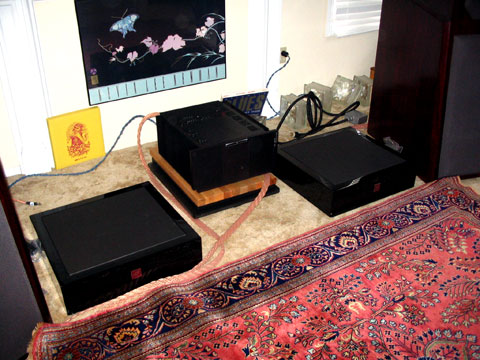|
You are reading the older HTML site
Positive Feedback
ISSUE
24
Doctor Sardonicus Examines the Concept of Precision at the Outer Reaches of Hi Fi-delity An Introduction to the Lamm M1.2 Hybrid Monoblock Power Amplifiers Precise. From Merriam Webster, "Pronunciation: pri-'sIs - Function: adjective - Etymology: Middle English, from Middle French precis, from Latin praecisus, past participle of praecidere to cut off, from prae- + caedere to cut.
Synonym see CORRECT Description The Lamm M1.2 Reference monoblocks are pure class "A" amplifiers featuring high-speed MOS-FET transistors in the output stage, no overall feedback and special switch-selectable bias/voltage settings for 8 or 4 Ohm operation. The bias setting switch provides for class "A" operation with a speaker loads of either 4 or 8 Ohms. The M1.2 is a hybrid design with one 6922 vacuum triode in the second amplification stage. The amplifiers are rated to deliver 110 Watts into 8 and 4 Ohms (class A); 220 Watts into 2 Ohms, and 400 Watts into 1 Ohm (low impedance setting), continuous.
Parts list includes: Military graded low noise DALE metal film resistors; PRC wire wound resistors; Electrocube and Roederstein film capacitors; high frequency switching grade Cornell Dublier electrolytic capacitors; Bourns multi-turn potentiometers; Hammon filter chokes; military graded low noise long life vacuum tubes; high quality heavy duty gold-plated binding posts and RCA jacks; gold-plated Neutric XLR connectors, and Camac-type coaxial connectors. The toroidal power transformer has no mechanical contact with either the transformer cover or the chassis and is suspended in a special "encapsulant" intended to absorb residual mechanical vibrations. The Lamm M1.2s can be configured to work on all world AC line voltages without elaborate modification. Description taken {edited} from the manufacturer's website
Detailed Specifications (http://www.lammindustries.com/PRODUCTS/m12spec.html) Retail: US $21,690 (the pair) Introduction Let us begin with the obvious truth. Vladimir Lamm doesn't need any more reviews. At the outer edge of the audio envelope there are few more readily recognized and respected names. The M1.2 hybrid reference monoblock amplifiers have garnered praise throughout the kingdom in their initial 1.0 iteration and now, once again, years later as the M1.2s. I was actually kinda surprised Mr. Lamm agreed to the review. The only stipulation he imposed was that I had to consider the M1.2 monoblock amplifiers and the LL2 line stage separately, at least initially; curious request that. Most manufacturers are much more comfortable with the fit of their own equipment. Mismatched equipment, however beautifully designed and executed, often produces less than stellar sonic results. It didn't take long to figure out why he wanted this arrangement. I think he had a point to make. This "point" is one of the major things I want to talk about in this review. But the question remains …what is there for me to review? There are any numbers of scholarly reviews of the M1.2s extant. Superlative adjectives are pretty much exhausted …and, let's face it, for over 20k, if these amps were not superior performers you would have already heard about it. But there are a significant number of amplifier choices for the discriminating audiophile at or below this price point. What is it that specifically distinguishes the Lamm M1.2 from the rest of them …why should someone buy this amplifier? This is a worthy question. Differentiating Amongst the Best …Why Bother? At the extreme end of the audio performance curve we reach a magical kingdom where it becomes relatively pointless to debate the absolute merit of equipment in the context of what are vanishingly small qualitative differences. Frankly, at this level responsible reviewers are mostly examining and trying to elucidate the aesthetic of the designer; it is Chagall and Gauguin, Mozart and Beethoven …and if you have a preference between them, it is just that …a preference. Whether these amplifiers are for you or not, is not a function of their absolute merit; on that basis they meet any reasonable requirement, any informed expectation. By any measurement you might wish to apply it is not possible to find fault here. These amplifiers were made as well as Mr. Lamm can make them. They are the mature expression of a talented and focused designer. Without some significant change in either technology or direction, I venture to say they are probably his statement expression. My interest here is not to rehash superlatives, or to try to blow nits up in some mean-spirited and misguided attempt to justify yet another review. But I am interested in exploring the man's art. My challenge is to accurately and adequately describe the M1.2s in words …to describe what they are. And what they are …above and beyond any other consideration …as their soul and reason for being …what they are, is a masterful expression of one engineer's obvious passion for precision. Consider the careful selection of the parts used in their construction. Observe the engineer's single-minded focus on functionality. The M1.2s have handles on BOTH the front and back. They can be configured to run on just about any AC scheme. There is variable input and output switching, which makes the M1.2s extremely flexible in operation. Take note of the substantial but not cosmetically overbuilt construction (I can lift one by myself, but not easily). Notice the unexpected touches like the sturdy wooden shipping crates, extensive measurement documentation and an operator's manual that you actually need to read (make note, it is not an owner's manual, it is an operator's manual) …and the list goes on. But what does it mean, Virginia? What it means, is the Lamm M1.2s are an engineer's dream: precise, practical, flexible, and unflappable. Forget about the 110 watt rating …it's bloody hard to tell how powerful they are in normal operation. Whatever you have at the front or back end of your chain, the Lamm M1.2s will adapt with aplomb. These are precision transducers in every sense of that description. I most deeply appreciate these amplifiers for the very reason that they are so utterly and completely, and without compromise, exactly what they are. I think I can almost intuit the designer's personality from this absolutely unflinching expression. This I admire enormously. The M1.2s are not audio "jewelry," they are serious tools. In the Lamm M1.2s the art of engineering becomes the undiluted expression of one person's vision. That, boys and girls, is the point! You may understand or not understand, you may agree or not agree …you may like or not like …but at least you will have a razor clear choice. There is nothing vague or ambiguous about the Lamm M1.2s. There are a handful of these kinds of audio products out there… true statement pieces. And lest we lose our way here, the appellation of "statement" in this context is given not just because they are expensive, which by the way …they are. Ok, so now we can all stipulate to the fact these are great amplifiers, but how do you know if they are going to be great for you? Dr. Sardonicus comes clean Note: I had originally written much of the basics of this review prior to something extraordinary happening to my reference system, and to me. Up to this point in the review you have been reading the original review text, and I stand by it in every way. However, as I begin to address how the amplifiers sound, I find it is time to come clean. Things have changed markedly for me with the surreal optimization of my reference system brought about through the combined use of JENA Labs AC filtering and wire (most especially the use of JENA Labs bi-wire on the speaker cables, as opposed to more conventional split wiring), and the Critical Mass Systems isolation stands. Frankly, some of the most basic conclusions I previously reached about the sound of this amplifier are no longer valid. It is now painfully obvious that a significant number of the sonic "characteristics" I attributed to the Lamm M1.2s are actually artifacts of interaction effects within my system, now substantially expunged. But what do you do when your world changes? As a journalist faced with a very uncomfortable reality I have the option to: 1. Ignore what happened. 2. Lie about, or cover up what happened. 3. Tell the truth about what happened. I think I am going to go with what's behind door number three. In order to do that, I am going to maintain the original text just as I wrote it, and then add my correction comments in italics so you can see the differences. Why? I guess at this point in my life I am simply more interested in being truthful than being right. So, we resume with the original text… Try this. If you crave and value order …if you are a bit put off by unseemly drama and the overt expression of strong emotion …if you are delighted by the mechanical precision of a fine Swiss watch …if you seek the highest level of detail and resolution in your listening and you relish the ability to put anything you wish at the front and the back of the listening chain (low impedance, high impedance, single-ended, balanced, etc.) …and you have the financial wherewithal, the M1.2 may well be at the top of a very short list of contenders. If you are an unabashed romantic, prone to nostalgia and more interested in feeling than thinking, perhaps the M1.2 is not your best choice. I was grinning as I wrote that last sentence, because I could just imagine Mr. Lamm frowning at the very idea of a romantic amplifier. Let me describe why… I confess to struggling with this review, largely because of the nature of the thing I am reviewing. By its very nature the Lamm M1.2 requires analysis. Frankly, I am more about feeling. But, to give proper respect, the Lamm M1.2 must be addressed in a rational and analytic way. And so I shall endeavor to do so… From this last bit of text, most readers would probably begin to infer that I found the M1.2s a bit clinical in presentation, and frankly I did. Not now. With proper system optimization I would characterize the overall presentation of the M1.2s as very linear and neutral, with an extremely high degree of resolution. Neither warm, nor cold, they are precise and without obvious coloration. Each recording is presented as a unique event, without euphonic carry over. And now we resume our regularly schedule program, in progress Functionality - We Begin The most rational and practical portion of any review is that which addresses the functioning of the piece under consideration. This is an engineer's amplifier. From the ineffably neat and carefully executed wooden packing crates to the two-step power-up toggles, you can see and feel the logic that runs through this creation. A word to the wise here, READ THE MANUAL FIRST. I know all manufacturers say that, but in this case, you really need to follow instructions.
Unlike most amplifiers that have simple ins and outs …things are different here. The M1.2 is prepared whatever your choice of sources; single-ended inverting, single-ended non-inverting, balanced inverting, balanced non-inverting …and you have to mess about with the provided shorting plugs based on what you are using. So, if you just plop them down, and hook them up with balanced cables (as I did) you will be greeted with a distressing amount of hum; this quickly alleviated by removing one of two pairs of shorting plugs (they are tiny and they are in with the power cables, so be careful not to lose them). Ahem, I did not intuitively expect shorting plugs. Secondly, you can switch the amp's output to 1-6 Ohm, or 8 ohms for speaker matching. You don't select different taps; that would obvious, but clumsy. Of course there are two sets of speaker taps but that is so you can bi-wire without the hassle of trying to jam two spades into a single terminal. Amplifier manufacturers of the world, ARE YOU LISTENING? Audiophiles need TWO, yes TWO, widely spaced, big knobbed sets of speaker terminals! Get with the program! In the case of the M1.2s there is a toggle switch on the back of the amplifiers for matching speaker impedance.
Do you begin to grok how thoughtfully this amplifier is designed? Next, the power switches are also on the back. They are relatively small … and you have to pull them out as you switch them on. If you don't pull them out before you flip them up, you will break them off and people will giggle at what a maroon you are. NO, I did not break them off! Uh, someone who knows me pretty well sternly warned me before I could break them off. I am so lucky in friendship. You get the basic idea. These are not just boxes with a switch. Read the book. While substantial, the amps are small enough for a single person to handle. I love the two handle arrangement and I wish more manufacturers would adopt it for anything over about thirty-five pounds. Hell, make them removable if you wish, but most of us would feel much better hefting our megabuck equipment around if we didn't have to worry so much our precious baby will slip out of our grasp and go crashing to the floor. Brrrrrr. I tried the Lamms directly on the floor, on maple slabs, and on Black Diamond shelves. Then I put them on the Critical Mass System Grand Reference stands, and that was pretty much the end of that little hegira. Precisely in the same way the Critical Mass impacted the incomparable Lindemann 820 SACD player, these stunningly attractive stands found obvious and essential synergy with the Lamm M1.2s. I thought the M1.2s might be just a tad bass shy on initial examination, but no, no, Nanook …they just needed proper foundations. I can't say enough about the Critical Mass Systems products; they are beautiful, affordable and they flat work.
In combination with the JENA Labs AC filtering and wire, the gestalt effect of the Critical Mass isolation system is simply incredible. This is not an incremental improvement; this is a new game altogether. We resume Ok, so I start out with the M1.2s lashed to my BAT VK-51SE line stage, with JENA Labs Pathfinder balanced interconnects (YES! Dammit, I am upgrading to the Dreamdancer, just shut up and let me be nuts, ok?). I pull the shorting plugs (eventually, blush); gently pull out and up on the power toggles and they start to blink red, and blink and blink and blink …almost like waiting for my SCD-1 to cue up a disc, or for my boss to develop a clue. How long did they blink? Well, the manual says 70 seconds. Remember, there be tubes here. Here is a piece of advice. These are class "A" amplifiers. They are supposed to run pretty hot. Frankly, listening to them before about 45 minutes of pre-heating has gone by is not much fun. Stone cold, they are mechanical sounding. My advice is to fire 'em up and go do something else for an hour. You may consider leaving them on all the time, but remember they run in pure class "A" mode, which means they are full-on all the time they are powered up, generating a significant amount of heat and burning a significant amount of power in the process. How do they Sound? I guess I am as prone to stereotypes as anyone. I kind of assumed that my experience with one Russian audio designer (Victor Khomenko of Balanced Audio Technology) would be somewhat paralleled with another, Vladimir Lamm. I mean, there are similarities; the no-nonsense appearance, both tubed and solid state equipment in the line, each of their first names begin with "V" …yeah …I know, I am reaching. Actually, the Lamm M1.2s and the BAT VK-600SE (my reference) form a most interesting contrast in sound; two superb amplifiers (ok, technically, three) that sound quite differently from each other. Actually, the sonic differences between these extraordinary amplifiers are not as pronounced as I originally experienced. The Lamms are not as analytical and the BAT is not so romantic, once the playback system is properly optimized. Like the master's carved carp in the famous Taoist story of art and pride, properly optimized, both simply disappear in the stream of music. Most obviously, I expected that at 110 watts a side the Lamms would be a bit less muscular in comparison with the VK-600SE's 300 watts. But at normal listening levels, there really wasn't that much difference. Pushed, the BAT does not run out of steam and the Lamms do, but that is at the threshold of pain. I suspect the M1.2s will be adequate for most loads under most conditions. Frankly, I heard virtually no compression from them Lamms while they were in my system, and I rock hard. I am thinking the high current design is why. I continue to believe that most conventional loudspeakers benefit from lots of current. While the BAT VK-600SE is immediately impressive, the Lamm monos are less so and somewhat harder to pin down. They are more …contained, perhaps less expressive in some ways. Oddly, although the BAT is pure solid state, in comparison with the Lamm it actually has more of that harmonic richness we tend to associate with tube amplification. The VK-600SE is significantly richer and warmer in presentation but no less detailed and revealing. The BAT VK-600SE does definitely cast a bit more of a tube "glow" than the Lamm, but to describe it as 'warm' to the Lamm's 'cool' is an overstatement and does both amplifiers a disservice. The Lamm (like a somewhat reserved sophisticate) reveals itself less readily. Poised and precise, I always had the definite impression it was methodically sorting things out. Even the most complex passages of orchestral and full-on rock failed to generate any anxiety in the M1.2s. Where the BAT would simply explode into a passionate declaration, the Lamm remained unflappable, contained and objective. I was impressed that the M1.2's did not compress under duress. Unlike some current audiophile darlings, they did not go all wimpy when asked to stand up and fight. These amps can rock just fine. This perceived analytic nature disappeared with system optimization. Frankly, when the system is actually revealing what is really on the recording, both Lamm and BAT amplifiers effectively disappear from the chain. There are no real errors of omission or commission with either, which might call them to the attention of the listener. As a result one tends to forget about them, which is just as it should be. What is the Utopian ideal again? Oh, yes, a straight wire with gain. The Lamms will politely but firmly point out any deficits in program material or upstream components, but without fussing too much about them. I think in direct A/B comparison these two amplifiers would produce a polarity of responses. This too is not accurate. I do think there is enough difference between them that most knowledgeable listeners would have a preference, but I doubt such preferences would be highly polarized. I am relatively certain any audiophile would gladly embrace either, after hearing heard them in my listening room. Ok, now …what follows next is what I intended to say in summary about the Lamm's sound …and however clever it may be (and personally, I think is quite clever) …it's unfortunately wrong. In the first Star Trek movie there is a scene at the beginning where Spock is about to be awarded a necklace symbolizing his attainment of the Kolinar, the state of absolute logic. Just as the priestess is about to place it around his neck, he stops her. She goes for the old mind-meld and surmises that his human side is being drawn to an unknown voice from space …his human side, his emotions, tripping him up once again. She drops the necklace to the ground and, without ceremony, tells him his destiny lies elsewhere. Alas, I am afraid I too must decline the necklace. As much as the Vulcan side of me appreciates the achievement represented by the Lamm M1.2s, my monkey side simply wants more of the drama than I can get from them. Alternate Ending This past weekend I listened to the Lamms through my unexpectedly transformed reference system and I was in tears more than once. To infer the M1.2s are not capable of strong emotional expression is incorrect. Prior to this weekend I had even decided to delay finishing this review until I could get a different set of speakers in my listening room, surmising the match up with the XHL Reference 1812s was not ideal. Additionally, there was something going on in the upper midrange that caused me to question the use of the 6922 as the possible culprit (this tube gets bagged on very often as a poor replacement for the 12AX7). Both issues simply disappeared with the changes in my reference system. A sad farewell to the XLH Reference 1812 loudspeaker As it is configured in my system currently (festooned with JENA Labs cables), try to imagine a horn speaker that sounds a lot like a good electrostatic in the upper mids and highs. The XLH Reference 1812 speakers are not perfect, but their execution of a compression horn to cover these ranges is pretty much perfect. Stunning accomplishment …and everyone who has heard them in my room has said the same thing. I won't miss their overwhelming size, but I certainly have enjoyed my time with them. Back to the Lamm M1.2s Bottom line …this is a world-class amplifier with no discernable errors of omission or commission. They are essentially flawless in operation. The M1.2s are more flexible than any other amplifier I have previously encountered. They represent the highest levels of audio engineering in a manner that must be respected and admired. Truly extraordinary! Post Script As you may have surmised, something extraordinary happened to me recently that has transformed my reference system and my experience of recorded music. This is not the venue to explain this experience in great detail, but rest assured, I will be writing about it at length. All I can say for now is, "something wonderful is going to happen." Additional Post Script As part of my "coming clean," I also need to return shortly to the VK-600-SE and update my initial review. For those of you who have relegated the BAT to the category of "romantic, but veiled" it's because you have truly not heard it. I truly love this amplifier, but in all fairness I am only now beginning to find out exactly what it is that I love. Stay tuned …
LAMM INDUSTRIES INC.
|






